AMD's Radeon HD 5870: Bringing About the Next Generation Of GPUs
by Ryan Smith on September 23, 2009 9:00 AM EST- Posted in
- GPUs
Eyefinity
Somewhere around 2006 - 2007 ATI was working on the overall specifications for what would eventually turn into the RV870 GPU. These GPUs are designed by combining the views of ATI's engineers with the demands of the developers, end-users and OEMs. In the case of Eyefinity, the initial demand came directly from the OEMs.
ATI was working on the mobile version of its RV870 architecture and realized that it had a number of DisplayPort (DP) outputs at the request of OEMs. The OEMs wanted up to six DP outputs from the GPU, but with only two active at a time. The six came from two for internal panel use (if an OEM wanted to do a dual-monitor notebook, which has happened since), two for external outputs (one DP and one DVI/VGA/HDMI for example), and two for passing through to a docking station. Again, only two had to be active at once so the GPU only had six sets of DP lanes but the display engines to drive two simultaneously.
ATI looked at the effort required to enable all six outputs at the same time and made it so, thus the RV870 GPU can output to a maximum of six displays at the same time. Not all cards support this as you first need to have the requisite number of display outputs on the card itself. The standard Radeon HD 5870 can drive three outputs simultaneously: any combination of the DVI and HDMI ports for up to 2 monitors, and a DisplayPort output independent of DVI/HDMI. Later this year you'll see a version of the card with six mini-DisplayPort outputs for driving six monitors.

It's not just hardware, there's a software component as well. The Radeon HD 5000 series driver allows you to combine all of these display outputs into one single large surface, visible to Windows and your games as a single display with tremendous resolution.
I set up a group of three Dell 24" displays (U2410s). This isn't exactly what Eyefinity was designed for since each display costs $600, but the point is that you could group three $200 1920 x 1080 panels together and potentially have a more immersive gaming experience (for less money) than a single 30" panel.
For our Eyefinity tests I chose to use every single type of output on the card, that's one DVI, one HDMI and one DisplayPort:
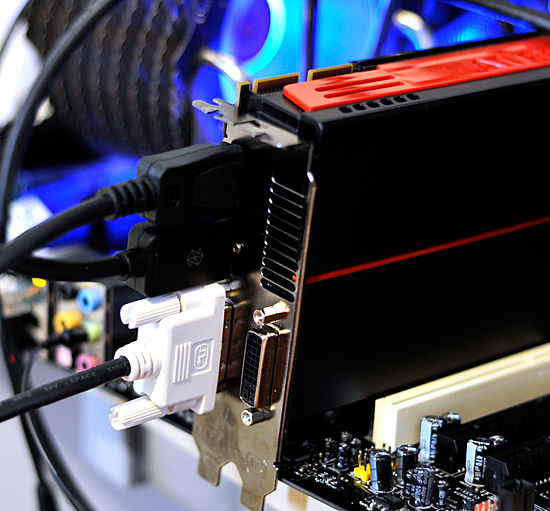
With all three outputs connected, Windows defaults to cloning the display across all monitors. Going into ATI's Catalyst Control Center lets you configure your Eyefinity groups:

With three displays connected I could create a single 1x3 or 3x1 arrangement of displays. I also had the ability to rotate the displays first so they were in portrait mode.

You can create smaller groups, although the ability to do so disappeared after I created my first Eyefinity setup (even after deleting it and trying to recreate it). Once you've selected the type of Eyefinity display you'd like to create, the driver will make a guess as to the arrangement of your panels.

If it guessed correctly, just click Yes and you're good to go. Otherwise ATI has a handy way of determining the location of your monitors:

With the software side taken care of, you now have a Single Large Surface as ATI likes to call it. The display appears as one contiguous panel with a ridiculous resolution to the OS and all applications/games:
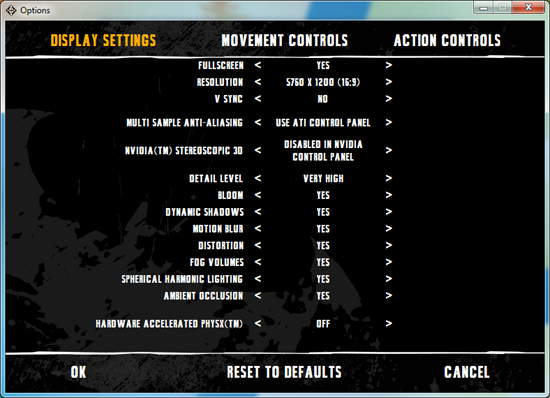
Three 24" panels in a row give us 5760 x 1200
The screenshot above should clue you into the first problem with an Eyefinity setup: aspect ratio. While the Windows desktop simply expands to provide you with more screen real estate, some games may not increase how much you can see - they may just stretch the viewport to fill all of the horizontal resolution. The resolution is correctly listed in Batman Arkham Asylum, but the aspect ratio is not (5760:1200 !~ 16:9). In these situations my Eyefinity setup made me feel downright sick; the weird stretching of characters as they moved towards the outer edges of my vision left me feeling ill.

Dispite Oblivion's support for ultra wide aspect ratio gaming, by default the game stretches to occupy all horizontal resolution
Other games have their own quirks. Resident Evil 5 correctly identified the resolution but appeared to maintain a 16:9 aspect ratio without stretching. In other words, while my display was only 1200 pixels high, the game rendered as if it were 3240 pixels high and only fit what it could onto my screens. This resulted in unusable menus and a game that wasn't actually playable once you got into it.
Games with pre-rendered cutscenes generally don't mesh well with Eyefinity either. In fact, anything that's not rendered on the fly tends to only occupy the middle portion of the screens. Game menus are a perfect example of this:
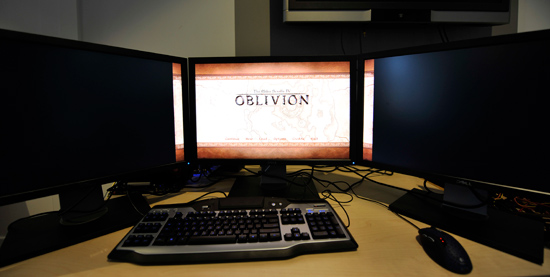
There are other issues with Eyefinity that go beyond just properly taking advantage of the resolution. While the three-monitor setup pictured above is great for games, it's not ideal in Windows. You'd want your main screen to be the one in the center, however since it's a single large display your start menu would actually appear on the leftmost panel. The same applies to games that have a HUD located in the lower left or lower right corners of the display. In Oblivion your health, magic and endurance bars all appear in the lower left, which in the case above means that the far left corner of the left panel is where you have to look for your vitals. Given that each panel is nearly two feet wide, that's a pretty far distance to look.
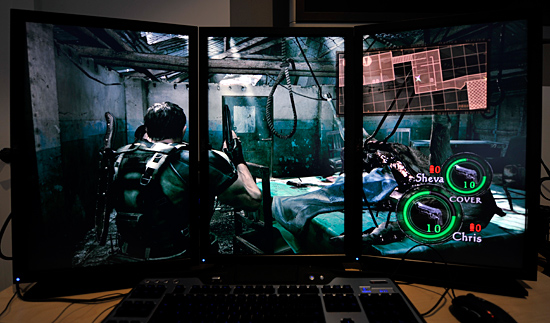
The biggest issue that everyone worried about was bezel thickness hurting the experience. To be honest, bezel thickness was only an issue for me when I oriented the monitors in portrait mode. Sitting close to an array of wide enough panels, the bezel thickness isn't that big of a deal. Which brings me to the next point: immersion.
The game that sold me on Eyefinity was actually one that I don't play: World of Warcraft. The game handled the ultra wide resolution perfectly, it didn't stretch any content, it just expanded my viewport. With the left and right displays tilted inwards slightly, WoW was more immersive. It's not so much that I could see what was going on around me, but that whenever I moved forward I I had the game world in more of my peripheral vision than I usually do. Running through a field felt more like running through a field, since there was more field in my vision. It's the only example where I actually felt like this was the first step towards the holy grail of creating the Holodeck. The effect was pretty impressive, although costly given that I only really attained it in a single game.
Before using Eyefinity for myself I thought I would hate the bezel thickness of the Dell U2410 monitors and I felt that the experience wouldn't be any more engaging. I was wrong on both counts, but I was also wrong to assume that all games would just work perfectly. Out of the four that I tried, only WoW worked flawlessly - the rest either had issues rendering at the unusually wide resolution or simply stretched the content and didn't give me as much additional viewspace to really make the feature useful. Will this all change given that in six months ATI's entire graphics lineup will support three displays? I'd say that's more than likely. The last company to attempt something similar was Matrox and it unfortunately didn't have the graphics horsepower to back it up.
The Radeon HD 5870 itself is fast enough to render many games at 5760 x 1200 even at full detail settings. I managed 48 fps in World of Warcraft and a staggering 66 fps in Batman Arkham Asylum without AA enabled. It's absolutely playable.
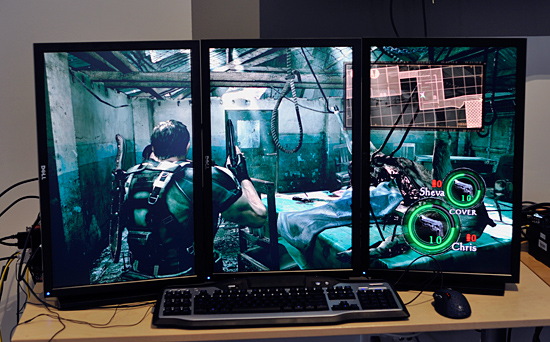










327 Comments
View All Comments
poohbear - Wednesday, September 23, 2009 - link
is it just me or is anyone else disappointed? next gen cards used to double the performance of previous gen cards, this card beats em by a measly 30-40%. *sigh* times change i guess.AznBoi36 - Wednesday, September 23, 2009 - link
It's just you.The next generations never doubled in performance. Rather they offered a bump in framerates (15-40%) along with better texture filtering, AA, AF etc...
I'd rather my games look AMAZING at 60fps rather than crappy graphics at 100fps.
SiliconDoc - Monday, September 28, 2009 - link
Golly, another red rooster lie, they just NEVER stop.Let's take it right from this site, so your whining about it being nv zone or fudzilla or whatever shows ati is a failure in the very terms claimed is not your next, dishonest move.
---
NVIDIA w/ GT200 spanks their prior generation by 60.96% !
That's nearly 61% average increase at HIGHEST RESOLUTION and HIGHEST AA AF settings, and it right here @ AT - LOL -
- and they matched the clock settings JUST TO BE OVERTLY UNFAIR ! ROFLMAO AND NVIDIA'S NEXT GEN LEAP STILL BEAT THE CRAP OUT OF THIS LOUSY ati 5870 EPIC FAIL !
http://www.anandtech.com/video/showdoc.aspx?i=3334...">http://www.anandtech.com/video/showdoc.aspx?i=3334...
--
roflmao - that 426.70/7 = 60.96 % INCREASE FROM THE LAST GEN AT THE SAME SPEEDS, MATCHED FOR MAKING CERTAIN IT WOULD BE AS LOW AS POSSIBLE ! ROFLMAO NICE TRY BUT NVIDIA KICKED BUTT !
---
Sorry, the "usual" is not 15-30% - lol
---
NVIDIA's last usual was !!!!!!!!!!!! 60.69% INCREASE AT HIGHEST SETTINGS !
-
Now, once again, please, no lying.
piroroadkill - Wednesday, September 23, 2009 - link
No, it's definitely just youGriswold - Wednesday, September 23, 2009 - link
Its just you. Go buy a clue.ET - Wednesday, September 23, 2009 - link
Should probably be removed...Nice article. The 5870 doesn't really impress. It's the price of two 4890 cards, so for rendering power that's probably the way to go. I'll be looking forward to the 5850 reviews.
Zingam - Wednesday, September 23, 2009 - link
Good but as seen it doesn't play Crysis once again... :DWe shall wait for 8Gb RAM DDR 7, 16 nm Graphics card to play this damned game!
BoFox - Wednesday, September 23, 2009 - link
Great article!Re: Shader Aliasing nowhere to be found in DX9 games--
Shader aliasing is present all over the Unreal3 engine games (UT3, Bioshock, Batman, R6:Vegas, Mass Effect, etc..). I can imagine where SSAA would be extremely useful in those games.
Also, I cannot help but wonder if SSAA would work in games that use deferred shading instead of allowing MSAA to work (examples: Dead Space, STALKER, Wanted, Bionic Commando, etc..), if ATI would implement brute-force SSAA support in the drivers for those games in particular.
I am amazed at the perfectly circular AF method, but would have liked to see 32x AF in addition. With 32x AF, we'd probably be seeing more of a difference. If we're awed by seeing 16x AA or 24x CFAA, then why not 32x AF also (given that the increase from 8 to 16x AF only costs like 1% performance hit)?
Why did ATI make the card so long? It's even longer than a GTX 295 or a 4870X2. I am completely baffled at this. It only has 8 memory chips, uses a 256-bit bus, unlike a more complex 512-bit bus and 16 chips found on a much, much shorter HD2900XT. There seems to be so much space wasted on the end of the PCB. Perhaps some of the vendors will develop non-reference PCB's that are a couple inches shorter real soon. It could be that ATI rushed out the design (hence the extremely long PCB draft design), or that ATI deliberately did this to allow 3rd-party vendors to make far more attractive designs that will keep us interested in the 5870 right around the time of GT300 release.
Regarding the memory bandwidth bottleneck, I completely agree with you that it certainly seems to be a severe bottleneck (although not too severe that it only performs 33% better than a HD4890). A 5870 has exactly 2x the specifications of a 4890, yet it generally performs slower than a 4870X2, let alone dual-4890 in Xfire. A 4870 is slower than a 4890 to begin with, and is dependent on Crossfire.
Overall, ATI is correct in saying that a 5870 is generally 60% faster than a 4870 in current games, but theoretically, a 5870 should be exactly 100% faster than a 4890. Only if ATI could have used 512-bit memory bandwidth with GDDR5 chips (even if it requires the use of a 1024-bit ringbus) would the total memory bandwidth be doubled. The performance would have been at least as good as two 4890's in crossfire, and also at least as good as a GTX295.
I am guessing that ATI wants to roll out the 5870X2 as soon as possible and realized that doing it with a 512-bit bus would take up too much time/resources/cost, etc.. and that it's better to just beat NV to the punch a few months in advance. Perhaps ATI will do a 5970 card with 512-bit memory a few months after a 5870X2 is released, to give GT300 cards a run for its money? Perhaps it is to "pacify" Nvidia's strategy with its upcoming next-gen that carry great promises with a completely revamped architecture and 512 shaders, so that NV does not see the need to make its GT300 exceed the 5870 by far too much? Then ATI would be able to counter right afterwards without having to resort to making a much bigger chip?
Speculation.. speculation...
Lakku - Wednesday, September 23, 2009 - link
Read some of the other 5780 articles that cover SSAA image quality. It actually makes most modern games look worse, but that is through no fault of ATi, just the nature of the SS method that literally AA's everything, and in the process, can/does blur textures.strikeback03 - Wednesday, September 23, 2009 - link
I don't know much about video games, but in photography it is known that reducing the size of an image reduces the appearance of sharpness as well, so final sharpening should be done at the output size.